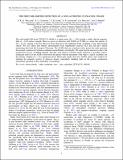Files in this item
The first millimeter detection of a non-accreting ultracool dwarf
Item metadata
| dc.contributor.author | Williams, P. K. G. | |
| dc.contributor.author | Casewell, Sarah L. | |
| dc.contributor.author | Stark, Craig Ronald | |
| dc.contributor.author | Littlefair, S. P. | |
| dc.contributor.author | Helling, Christiane | |
| dc.contributor.author | Berger, E. | |
| dc.date.accessioned | 2016-01-21T12:10:05Z | |
| dc.date.available | 2016-01-21T12:10:05Z | |
| dc.date.issued | 2015-12-09 | |
| dc.identifier | 240205472 | |
| dc.identifier | a520ca6b-9a67-4e90-93b2-3714a4f531de | |
| dc.identifier | 84951290077 | |
| dc.identifier | 000367105000064 | |
| dc.identifier.citation | Williams , P K G , Casewell , S L , Stark , C R , Littlefair , S P , Helling , C & Berger , E 2015 , ' The first millimeter detection of a non-accreting ultracool dwarf ' , Astrophysical Journal , vol. 815 , no. 1 . https://doi.org/10.1088/0004-637X/815/1/64 | en |
| dc.identifier.issn | 0004-637X | |
| dc.identifier.uri | https://hdl.handle.net/10023/8053 | |
| dc.description | We acknowledge support for this work from the National Science Foundation through Grant AST-1008361. Ch.H. acknowledges support from the European Community under the FP7 by the ERC starting grant 257431. | en |
| dc.description.abstract | The well-studied M9 dwarf TVLM 513–46546 is a rapid rotator (Prot ∼ 2 hr) hosting a stable, dipolar magnetic field of ∼3 kG surface strength. Here we report its detection with ALMA at 95 GHz at a mean flux density of 56 ± 12 μJy, making it the first ultracool dwarf detected in the millimeter band, excluding young, disk-bearing objects. We also report flux density measurements from unpublished archival VLA data and new optical monitoring data from the Liverpool Telescope. The ALMA data are consistent with a power-law radio spectrum that extends continuously between centimeter and millimeter wavelengths. We argue that the emission is due to the synchrotron process, excluding thermal, free–free, and electron cyclotron maser emission as possible sources. During the interval of the ALMA observation that phases with the maximum of the object’s optical variability, the flux density is higher at a ∼1.8σ significance level. These early results show how ALMA opens a new window for studying the magnetic activity of ultracool dwarfs, particularly shedding light on the particle acceleration mechanism operating in their immediate surroundings. | |
| dc.format.extent | 6 | |
| dc.format.extent | 427669 | |
| dc.language.iso | eng | |
| dc.relation.ispartof | Astrophysical Journal | en |
| dc.subject | Brown dwarfs | en |
| dc.subject | Radio continuum : stars | en |
| dc.subject | Stars: individual (TVLM 513-46546) | en |
| dc.subject | QB Astronomy | en |
| dc.subject | QC Physics | en |
| dc.subject | NDAS | en |
| dc.subject.lcc | QB | en |
| dc.subject.lcc | QC | en |
| dc.title | The first millimeter detection of a non-accreting ultracool dwarf | en |
| dc.type | Journal article | en |
| dc.contributor.sponsor | European Research Council | en |
| dc.contributor.institution | University of St Andrews. School of Physics and Astronomy | en |
| dc.identifier.doi | 10.1088/0004-637X/815/1/64 | |
| dc.description.status | Peer reviewed | en |
| dc.identifier.url | http://arxiv.org/abs/1511.05559 | en |
| dc.identifier.grantnumber | 257431 257431 | en |
This item appears in the following Collection(s)
Items in the St Andrews Research Repository are protected by copyright, with all rights reserved, unless otherwise indicated.

